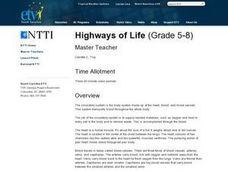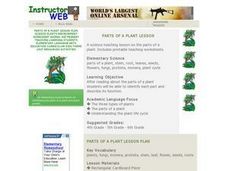Curated OER
Fortified Breakfast
Students reverse engineer a cereal. In this dietary lesson students identify the minerals that the human body needs to function. Students examine how foods are fortified by food engineers. Students find the amount of iron in a cereal by...
Scholastic
Study Jams! The Nervous System
Get your class thinking with animations of neurons in action and explanations of how stimuli is transported and processed. This film makes an ideal introduction or review of the nervous system. The parts of the brain and what they...
Children’s Hospital of Philadelphia
Organs and Tissues of the Immune System
It's virus-fighting time! Pupils learn how viruses attack and reproduce and how the immune system works to protect the body. They identify unfamiliar terms and tissues and organs of the immune system. Working in small groups, scholars...
Curated OER
The Circulatory System--Part III
Learners research the process for the preparation of a soup. Students explore the safety issues of food preparation. Learners, after presenting their soups to the class, will eat their soups that they have prepared.
Curated OER
What Happens to Our Hearts When We Are Active?
Students discover the benefits of a healthy heart through exercise. In this physical education lesson, students participate in a few physical activities in order to get their hearts beating faster. Students examine a visual image of an...
Curated OER
Building Bodies
Students identify key anatomical similarities and differences between great apes and humans. They infer likely anatomical features in ancient human ancestors and list principal anatomical changes in primates necessary for adaptation to...
Curated OER
The Circulatory System - Part II
First graders recognize that the heart muscle requires food. Students observe a Venn Diagram to identify foods that are good for them. Students provide one ingredient to make healthy heart soup.
BBC
Ourselves
Young biologists identify parts of the body, sort humans from other animals, and list the difference they see. Learners are split up into groups of three, and each group must find pictures in magazines of humans and other animals. They...
Gallantsbiocorner.com
Cell Organelles
Young scientists take a trip into the microscopic world of cellular biology with this practice exercise. Given pictures of different organelles, students must correctly identify specific parts of each cellular structure to demonstrate...
Curated OER
Highways of Life
Students explore the circulatory system. They participate in media activities to explore blood flow and identify the parts of the circulatory sytem. Students create a model of the circulatory system.
Curated OER
Cell Parts
Students identify parts of a cell. In this biology lesson, students create a simulated cell by using Jell-o, fruit roll ups, raisins, gum drops, and M&M's. Students construct the simulated cell and identify each part.
NASA
Biology Training Conclusion
Gravity is just one consideration when determining human habitability on a new planet. The lesson plan connects four different units and starts with connecting the various systems: planetary systems, human body systems, etc. After...
Curated OER
Naming the Body Parts
Students study about butterfly and catepillar parts. Throughout the week, they use various notecards, overhead transperancies, books, and matching games to study about the part names. They are given a test to fill in blanks with the...
Curated OER
IDENTIFYING PARTS OF THE BODY
Learners identify and describe the various parts of the body therefore, practicing English vocabulary, pronunciation, and spelling. They discuss the various body parts, some of the inner organs and also, their functions. Finally,...
Curated OER
Whose Parts Do I Have? (Wings and Things)
Learners identify an animal and a body part and then matches a body part to a specific animal. This will assess their ability to sort organisms and objects into groups according to their parts and describe how the groups are formed and...
Curated OER
Parts of a Plant Lesson
Learners, after reading about the parts of a plant, identify each part and describe its function.
Curated OER
Circulatory Circles
Students investigate the circulatory system. In this circulatory system lesson, students complete a WebQuest and explore all the areas of the heart. Students determine the functions of different parts of the circulatory system and...
Curated OER
Drawing Upon Our Five Senses
Fifth graders identify the parts and functions of the body's five senses. In this biology instructional activity, 5th graders create a replica of the nervous system highlighting its parts. They create a scrapbook containing information...
Curated OER
Animals Jeopardy
This animal science PowerPoint enables students to review the habitats and body parts of animals by participating in a Jeopardy review game. This interactive review game includes illustrations of animals as well.
Curated OER
Smart Ideas Lesson Plan
Seventh graders create a concept map about the cardiovascular system. For this life science lesson, 7th graders identify the parts and functions of each system component. They explain how cardiovascular system works with other systems in...
Curated OER
Mythical Animals
Learners create imaginary animals by assembling pictures of body parts from pictures of real animals. This is one of three linked tasks. The others are "Who's Parts Do I Have?" and "Animals Piece by Piece."
Purdue University
Reptiles, Amphibians, and the Scientific Method
What do a reptile and an amphibian have in common? A three-part lesson allows scholars to investigate the similarities and differences between the two types of animals by identifying specific body parts. The lesson highlights the...
Curated OER
What Is An Insect?
Students find and classify insects. They collect insects, study them with a hand lens and identify its body parts. Afterwards, they discus various types of insects and thier Orders such as beetles, butterflies and moths, grasshoppers, etc.
Desert Discoveries
Bird and Feather Features
Ornithology is the study of birds, and young scientists do just that with an interesting science lesson. They identify the parts of a bird, realize that birds have different types of beaks, wings, and feet, and take a close look at bird...

























